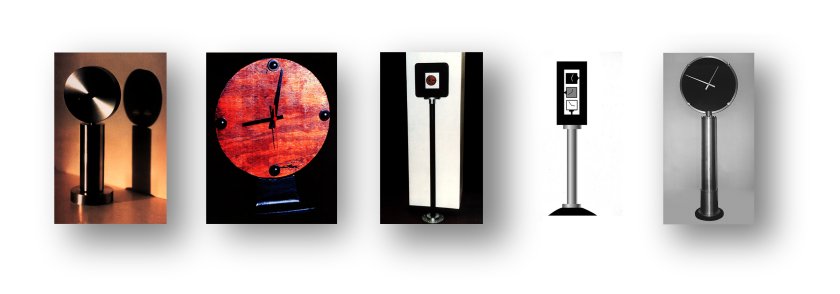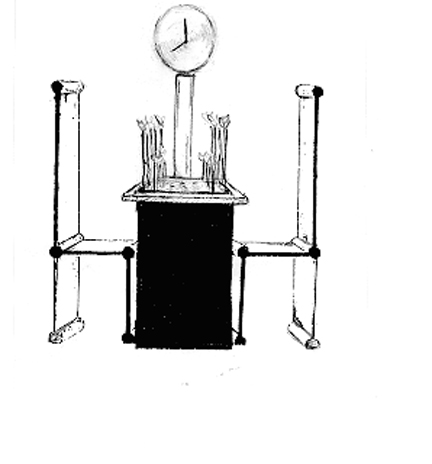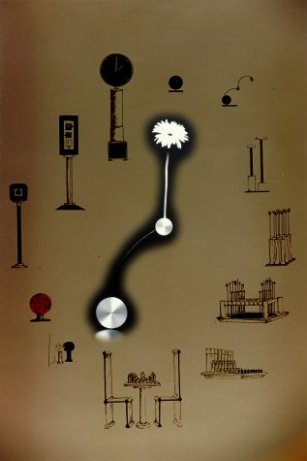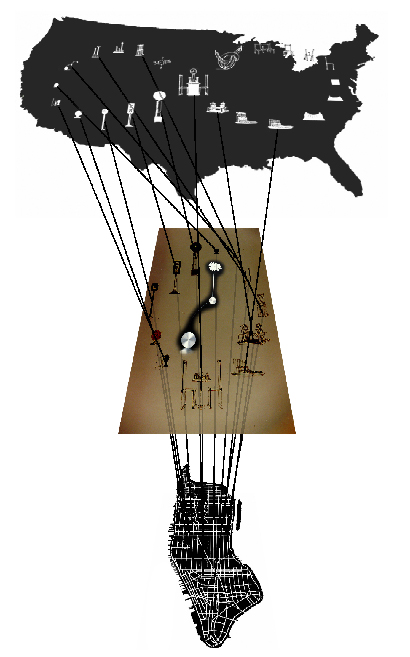|
TimeSculptureConstructing Social
Geometries
John Sims Ringling School Art and Design
Abstract
This sculpture narrative begins with a
sequence of vases. The designs of the vases incorporates visual notions
of order to address issues surrounding the captivity, organization and
management of space. The chess sets use symmetry to discuss power dynamics
in the arenas of Nature/Nature, Nature/Human and Human/Human conflicts.
The sequence of chairs shares a story about the beauty and structure of
support, family, love and loyalty stemming from human relationships. The
collection of clocks mimics the human growth cycle. These four design narratives
form TimeSculpture. The conceptual paradigm is summarized in the following
way.
Descriptions Here we present and describe the sequences
of objects that form the TimeSculpture.
Vases Let us define a vase as a container of
space. The black disk, in the Vase of Space pays tribute to the
organic nature of the circle and its radial symmetry that cradles space
as the fundamental nutrient for movement. With Vase of Vase of Flower
we illustrate through a notion of iteration and composition the birthing
process of an abstract flower to a real one, producing a flower clock,
which reads seven o’clock. Vases of Metal Flowers follows with cylindrical
and cubic vases and metal flowers that introduces the idea of complementarism
as a generalization of male-female structure. The next vase in the series
is Floragraphs, which shows the intersecting graphs that represent
the quadratic growth of love with red roses and the linear decline of deaths
with white roses. Alles ist in Ordnung is a vase for nine white
roses, all of the same height ordered in a square. This construction is
essentially the average between a vase for one flower and a vase for many
flowers that could either promote sameness, unity and order or an army
of flowers resistant to diversity, uniqueness and flexibility. This vase
also admits a random arrangement. By extending the ideas of the previous
vases to the six sides of a cube we arrive at Vase for Space, which
is a vase designed for zero gravity.
Chess Sets The chess sets provide a metaphor for conflict and the competition for space and resources. Our chess sequence starts with the Chess Set with Flowers, which frames the ultimate conflict in terms of nature versus nature.
Chess Sets with Nature introduces
the human versus nature on a asymmetrical chessboard that illustrates the
power structure and advantages that nature has over humans. The next chess
set Asymmetrical Chess shows with a similar asymmetrical chessboard
the power imbalance existing in human communities. The design of this particular
chess set is a response to the fact that white pieces still move first
in competition chess. Using symmetry, Chess Set for the Colorblind
provides a game where Black and White, Cowboys and Indians and Spaniards
and Incas images are not necessary to facilitate a conflict between the
players. To play, the players must simply remember where they moved. The
last chess set in this sequence is the Squareless Chess, where the
board has vanished leaving the players to work together to construct and
agree on a unit of space. The growth and then disappearance of the board
structure celebrate the independence from ordered space.
Chairs The chairs sequences give a romantic story about love, family and loyalty. The story begins with the lone chair in the Sub-dimensional Chair. This chair meets another chair and falls in love in Chairs in Love. The two chairs become married in Chairs in Marriage and proceed to make a family with children in Family of Chairs. The story ends with Hyper-dimensional Rocking Chair, which shows that even through the knots of life, the chairs have formed an unbroken bond that testifies to their love, loyalty and balance of personal and shared space.
Clocks
With the clocks sequences we chart the
growth the development of a clock as it mimics the human growth cycle.
The Fertility Clock is a clock whose shadow has the image of an
African fertility doll. The
Child Clock, with round fat face shows
the innocence of youth, while the
Self Portrait Clock with the newly
emerged square depicts the intellectual birth in human adolescents. This
clock measures over six feet tall. The
Traffic Clock shows the relationship
and traffic between three modes of times: personal, community and global.
The time on this clock is revealed by averaging the times of the three
clocks. The ten foot
Grandson Clock speaks of the grace, wisdom
and maturity that comes with age. Note that this clock has return to the
Fertility Clock in form.
VaseChessChairClock --- TimeSculpture NYC: The Map The VaseChessChairClock is a symmetrical
sub-installation that includes a vase, chess set, chair and a clock providing
a site of transition for the Timesculpture NYC and a center site
for the completed
TimeSculpture USA. The TimeSculpture NYC,
as a collection of twelve objects will be placed in New York City in publicly
accessible places; for instance shops, hospitals, hotel lobbies, etc. These
objects will be connected by a lighting system that will light each object
one after the other. Posters will be distributed around the city to advertise
the locations of the objects. Auxiliary projects will include a novel,
animation film and a sonic clock installation.
TimeSculpture USA Conclusion After the TimeSculpture NYC has been completed,
it will be extended to TimeSculpture USA by joining together the vases,
chess sets, chairs, clocks and intersecting the sub-installation. These
objects, as models for outdoor public structures, will be mapped into 23
communities that speak to the breath and complexity of the American spirit.
The structures in these communities will be connected by both a lighting
system and website (www.timesculpture.com).
TimeSculpture A Mapping for a National Instalation
The TimeSculpture is an attempt to use familiar designs to convey the depth in meaning of objects around us that have encoded ideology and consciousness of past generations. By using mathematical ideas to promote new ways of seeing and designing objects around us, we have created a plan for a national installation that tells short visual stories concerning the issues of Space, Conflict, Relationships and Time. As the structures of the TimeSculpture are placed across United States, it becomes a collection of transformations, embeddings, and mappings that allows one to travel across abstract spaces, time zones, cultural stratifications, and diverse geographies, witnessing the richness of variations and the density of connections that characterize the evolving power and presence of globalization in the seductive search for universal cycles. The author wishes to indicate the following references as visual and intellectual inspiration for the TimeSculpture. 1. Braitenburg, Valentino, Vehicles: Experiments in Synthetics Psychology, MIT Press, 1984 2. Braxton, Anthony, Reflection Paper No.1, Unpublished, acquired in 1996 3. Browder, Sarah and Sims, John, Dance/Installation, " At the Tone the Time will be..." Wesleyan University Fall 95, Spring 96 4. Christo, CHRISTO: WRAPPED WALK WAY, Harry N. Abrams, Inc, Publishers, New York, 1978 5. Dali, Salvador, Soft Watch at the Moment of First Explosion, 1954 6. Friedman, Dan, Dan Freidman: Radical Modernism , Yale University Press, 1994 7. Sims, John, TimeSculpture, Artbyte, May-June, 2000 8. White, Robert, Cellars of Cosmic Manipulation : A Micro-Installation,
1995
Acknowledgement The author acknowledges the following sources of support for this work in progress. ¨ Mathematics Department and Machine Shop at Wesleyan University, Middletown CT ¨ Ringling School of Art and Design, Sarasota, Fl ¨ DFN Gallery, NYC ¨ Sarasota Visual Art Center, Sarasota Fl ¨ Creative Arts Workshop, New Haven CT ¨ Rush Arts Gallery, NY,
NY
|







